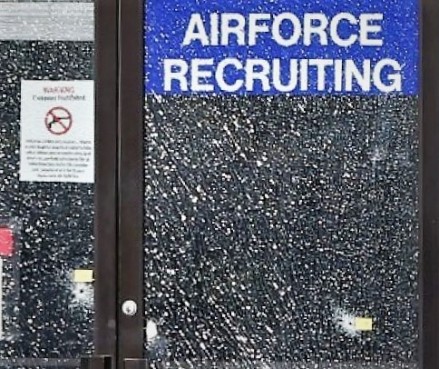





U.S.—In a rash of tragedies all across the United States, every single bump stock in the nation was tragically lost in various boating accidents earlier this week.
Coincidentally, the bump stocks have just been banned by the Trump administration. Since all the bump stocks have been destroyed, it’s now impossible for the ATF to confiscate them or fine people who did not destroy them.
“Well, I guess our job is done,” an ATF representative said. “We were gonna have to make sure people complied with this unilateral executive order, but now I guess we can just harass gun owners for other stuff. Worked out pretty nicely for all of us, I think.”
It’s not clear why gun owners were taking their bump stocks boating. Some have theorized they were using them to fish, or just wanted to make sure they weren’t stolen why they were away. Whatever the case, it’s tragic that the bump stocks are now all at the bottom of lakes, rivers, and oceans from coast to coast.

An intact marriage is a powerful preventative for public violence. You already knew that, and from several sources. It confirms your suspicions that the mass murderers in 26 of our 27 deadliest attacks came from fatherless homes. You already knew that most violent criminals are men. You noticed that most violent criminals grew up without a father.
You knew that boys are more sensitive than girls to family breakup. Boys need a nurturing mother AND a disciplinarian father so that the boys grow to become socially attached and psychologically whole.
Boys learn patience and emotional resilience from their father. You knew that boys become frustrated-and-angry outcasts when they fail to learn those lessons.
Fatherless boys and girls are delayed or depressed in dozens of social markers. However, the expression of that failure in the form of public violence is usually seen in boys rather than in girls.
I did not say that unwed moms produce mass murderers. I said that adults who lack self-control predominantly come from homes without a father.
If you want a society where people control their violent impulses, then you should support marriage.
Our immersion in the media culture has grown enormously over time and at an accelerating rate. Today we carry video media in our pocket. Our media exposure is so pervasive that most children spend more time watching screens than interacting with real people.
Unfortunately, the news and entertainment media work hard to keep our attention. If it bleeds it leads..and the coverage of mass murder lasts for days. Add the fact that some angry and narcissistic young men will do anything for fame.
After the next mass murder, the news media will flood us with the murderer’s face and name as they turn the murderer into a celebrity. That billion dollar media blitz is an advertising campaign, a casting call, searching for the next mass murderer.

Media analysts and psychologists say we could cut the rate of mass murder by a third to as much as half. All we have to do is stop turning these murderers into celebrities.
There are media guidelines in place that stop news organizations from showing the face and saying the name of the mass murderer. Only a few US media organizations have signed on.
Yes, you can watch the news without becoming a mass murder. The same isn’t true for narcissistic psychopaths and sociopaths. We have to stop rewarding these narcissists if we want to stop mass murders.
Synthetic Violence
Killing our fellow man is unthinkable for most of us. Immersing ourselves in simulated violence makes killing easier. By the time we reach our early 20s, most of us have seen a quarter million violent acts on TV.
The murderer at Sandy Hook Elementary School who killed 20 children and seven adults immersed himself in video games as he failed in his real relationships. He played 4,901 simulated combat matches over more than 500 hours. He killed 83,496 characters. During that simulated violence, he shot 22,725 characters in the head in order to kill them. He later repeated that exercise in real life at a public school.
I’m glad that you can play video games without becoming a murderer. Some people can’t. If you want to save lives then stop teaching our kids to kill.
We emptied most of our mental hospitals in the 1960s. Some of the mentally ill were successfully treated in local treatment facilities. Many were not. Our response to dealing with the mentally ill was to make all of society into a low-quality mental institution. That isn’t a sophisticated or targeted solution.
Many mass murderers have a history of violence and mental illness. Politicians tell us to say something if we see something..and we have.
The Federal Bureau of Investigation and the Bureau of Alcohol Tobacco Firearms and Explosives were called many times about the murderer at the Pulse Nightclub in Orlando, Florida. They were called before the murders at Parkland High School in Florida.
The police were called to the Parkland murderer’s home 45 times and no one asked for a mental evaluation to make the murderer prohibited from owning firearms.
Government agencies would rather look the other way than to do their job. If you want to stop mass murderers then we have to hold politicians and bureaucrats accountable for their mistakes.
 Killing Zones
Killing ZonesPrevention only takes us so far. Unfortunately, we cannot identify all of the people who will become violent just as we can not tell which people with heart conditions will suffer a heart attack tomorrow. That means we should prepare to deal with heart attacks and with school attacks in order to save lives. We have to plan our response in addition to implementing preventative measures.
In too many cases, we’ve deliberately prohibited a defensive response to public violence. Mass murderers look for crowds of defenseless victims. We are 30 times more likely to be attacked in a “gun-free” zone. Stop creating hunting grounds for sociopaths by disarming the victims.Summary
Our divorce rate here in the US doubled since the 1930. Reversing that trend and saving your marriage may save your children. Our news and entertainment media is violent and voracious. Stopping “celebrity violence” will clearly save lives.
Stop teaching our kids to kill. Eliminating “gun-free” zones reduces the times and places where mass murderers will strike. All of those solutions are simple and easily achievable compared to making bureaucrats do their job. All are worth it because each one saves lives.
References-
http://thefederalist.com/2015/07/14/guess-which-mass-murderers-came-from-a-fatherless-home/
https://www.patheos.com/blogs/markmeckler/2018/02/27-deadliest-mass-shooters-26-one-thing-common/
https://www.foxnews.com/opinion/the-desperate-cry-of-americas-boys
https://townhall.com/columnists/rachelalexander/2018/03/06/dr-warren-farrell-explains-the-boy-crisis-n2457856
https://www.apa.org/news/press/releases/2016/08/media-contagion.aspx
http://jpfo.org/d.i.e/die-partners.htm
http://pediatrics.aappublications.org/content/124/5/1495
https://onlinelibrary.wiley.com/doi/abs/10.1002/bin.84
https://www.chicagotribune.com/news/opinion/commentary/ct-perspec-mass-shooters-russia-public-shootings-thousand-oaks-mercy-hospital-chicago-1121-story.html?fbclid=IwAR1aeWbewgcl8ihvia8RLmDO6onfFVTm-adSxwW4-2LC02GeJWHnu1JcGcU
https://crimeresearch.org/2018/06/more-misleading-information-from-bloombergs-everytown-for-gun-safety-on-guns-analysis-of-recent-mass-shootings/
~_~_
 If you are married or have a woman in your life. Then you will understand this one!
If you are married or have a woman in your life. Then you will understand this one!


(CNSNews.com) – California ranks No. 1 among the 50 states for the percentage of its residents 25 and older who have never completed ninth grade and 50th for the percentage who have graduated from high school, according to new data from the Census Bureau.
Texas ranks No. 2 for the percentage of its residents 25 and older who have never completed ninth grade and 49th for the percentage who have graduated from high school.
9.7 percent of California residents 25 and older, the Census Bureau says, never completed ninth grade. Only 82.5 percent graduated from high school.
8.7 percent of Texas residents 25 and older never completed ninth grade, and only 82.8 percent graduated from high school.

California and Texas—while having the highest percentages of residents 25 and older who never finished ninth grade and the lowest percentages who graduated from high school—are the nation’s two most populous states.
In fact, the 2,510,370 California residents 25 and older who, according to the Census Bureau, never finished ninth grade outnumber the entire populations of 15 other states.
In California, children are required to attend school from six years of age until they are 18. “California’s compulsory education laws require children between six and eighteen years of age to attend school, with a limited number of exceptions,” says the California Legislative Analyst’s Office, an agency of the California state government.
(The National Center for Education Statistics also indicates that children in California are compelled by law to attend school from 6 to 18 years of age.)
Massachusetts ranks No. 1 for the percentage of its residents 25 and older—42.1 percent–who have earned at least a bachelor’s degree.
These rankings are based on data from the Census Bureau’s American Community Survey 5-year estimates, which were released this month.
In the survey, the Census Bureau asks respondents to specify the level of educational attainment for each individual in their household. The question is: “What is the highest degree or level of school this person has COMPLETED. Mark (X) ONE box. If currently enrolled, mark the previous grade or highest degree received.”
The survey form then offers the respondent multiple options ranging from “no schooling completed” to “professional degree” or “doctorate degree.” If an individual has not earned a high school degree, the respondent is asked to specify the highest grade the individual actually completed—ranging from “nursery school” through “12th grade—NO DIPLOMA.”
The Census Bureau’s American Community Survey queries a random sample of more than 3.5 million U.S. households each year and publishes a one-year estimate for each year. The five-year estimate, the bureau says, “is a weighted average of the five one-year estimates.” The newly released five-year estimates are for the period from 2013 through 2017.
Nationwide, 5.4 percent of residents 25 and older have never finished ninth grade, according to the latest five-year estimates.
Ten states exceeded the nationwide level of residents 25 and older who have never finished ninth grade. These include: California (9.7 percent), Texas (8.7 percent), New York (6.5 percent), New Mexico (6.5 percent), Kentucky (6.1 percent), Nevada (5.9 percent), Arizona (5.9 percent), Mississippi (5.6 percent), Rhode Island (5.5 percent), and Louisiana (5.4 percent).
Wyoming—with 1.8 percent—had nation’s smallest percentage of residents 25 and older who never finished ninth grade.
In seventeen states, the percentage of residents 25 and older who at least graduated from high school was less than the nationwide percentage of 87.3 percent.
These seventeen states included: California (82.5 percent), Texas (82.8 percent), Mississippi (83.4 percent), Louisiana (84.3 percent), New Mexico (85 percent), Kentucky (85.2 percent), Alabama (85.3 percent), Arkansas (85.6 percent), Nevada (85.8 percent), West Virginia (85.9 percent), New York (86.1 percent), Georgia (86.3 percent), Tennessee (86.5 percent), South Carolina (86.5 percent), Arizona (86.5 percent), North Carolina (86.9 percent), and Rhode Island (87.3 percent).

Nationwide, 30.9 percent of residents 25 and older have a bachelor’s degree or higher.
In nineteen states, the percentage with a bachelor’s degree or higher exceeds the national percentage. These nineteen states include both No. 14 California (32.6) and No. 9 New York (35.3), which respectively ranked No.1 and No. 3 for the percentage of residents 25 and older who never finished ninth grade.
The ten states with the highest percentage of residents 25 and older who earned a bachelor’s degree or higher are: Massachusetts (42.1 percent), Colorado (39.4 percent), Maryland (39 percent), Connecticut (38.4 percent), New Jersey (38.1 percent), Virginia (37.6 percent), Vermont (36.8 percent), New Hampshire (36 percent), New York (35.3 percent), and Minnesota (34.8 percent).
West Virginia—at 19.9 percent—has the lowest percentage of residents with a bachelor’s degree or higher.
In another seven states, the percentage of residents who have a bachelor’s degree or higher is less than 25 percent. They are: Mississippi (21.3 percent), Arkansas (22 percent), Kentucky (23.2 percent), Louisiana (23.4 percent), Nevada (23.7 percent), Alabama (24.5 percent) and Oklahoma (24.8 percent).

In California, according to the Census Bureau’s five-year estimates, the resident population 25 and older was 25,950,818. Of those individuals, 2,510,370—or 9.7 percent–never completed ninth grade.
Another 2,033,160 California residents 25 and older completed the ninth, tenth, eleventh or twelfth grade—but did not earn a high school diploma. Thus, a total of 4,543,530 California residents 25 and older—or a nation-leading 17.5 percent–have never graduated from high school.
Those 2,510,370 individuals 25 and older in California who never finished 9th grade outnumber the entire populations of 15 other states, according to the Census Bureau’s latest population estimates. These include: Alaska (737,438), Delaware (967,171), Hawaii (1,420,491), Idaho (1,754,208), Maine (1,338,404), Montana (1,062,305), Nebraska (1,929,268), New Hampshire (1,356,458), New Mexico (2,095,428), North Dakota (760,077), Rhode Island (1,057,315), South Dakota (882,235), Vermont (626,299), West Virginia (1,805,832), and Wyoming (577,737).

In Texas, the resident population 25 and older was 17,454,431. Of those individuals, 1,513,995—or 8.7 percent—never completed ninth grade. That outnumbers the populations of 11 states.
